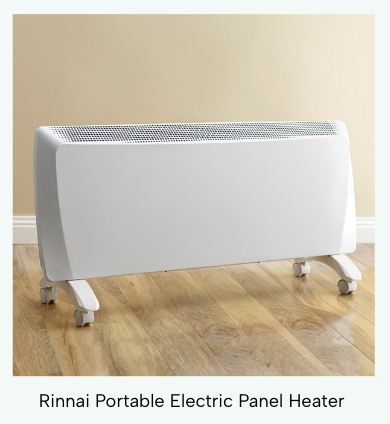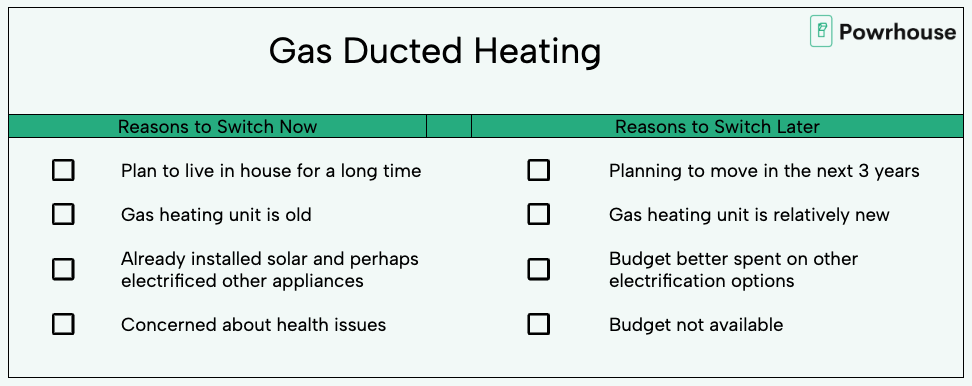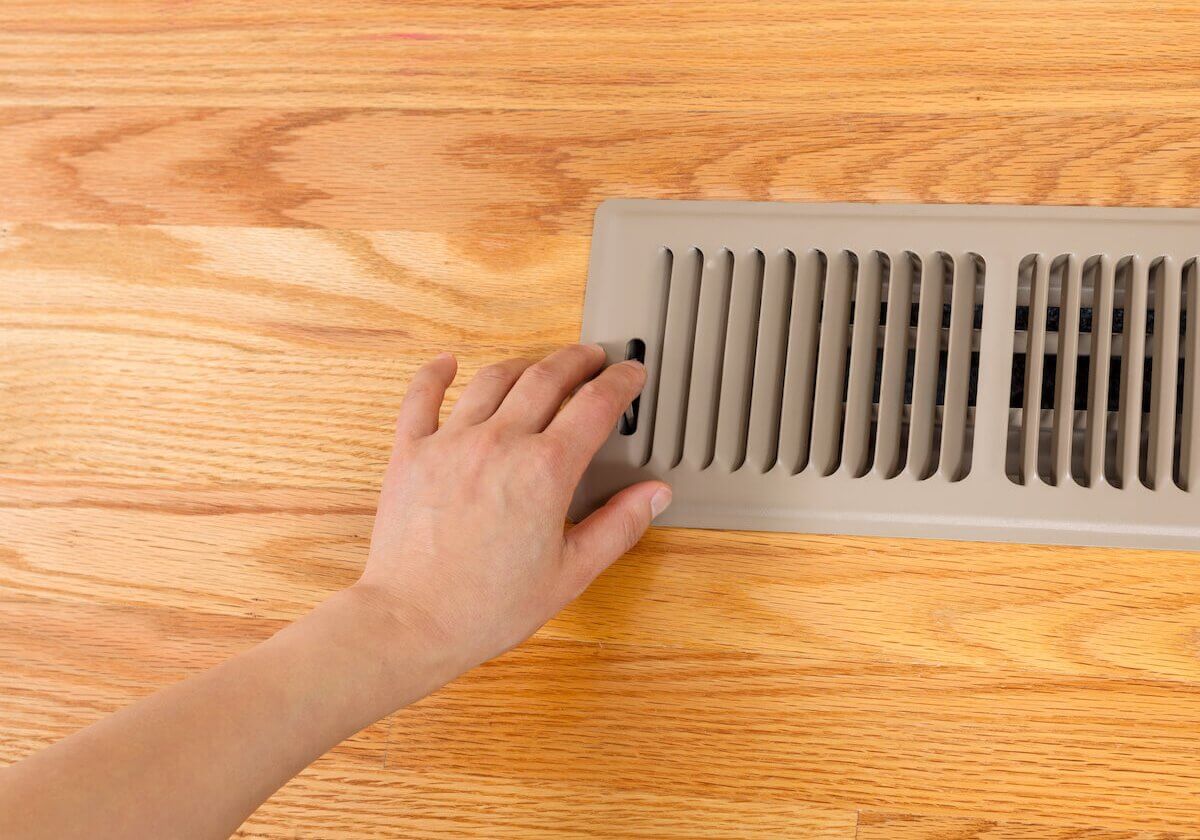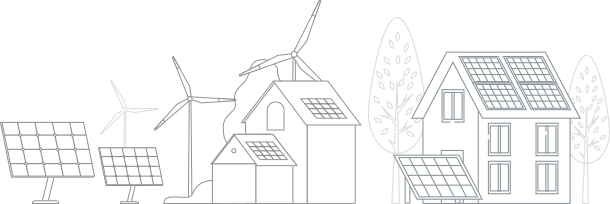Gas ducted heating is ubiquitous throughout Victorian homes. We estimate that 75-85% of our clients have gas ducted heating. While it worked well in a time when energy was cheap and climate concerns were secondary, many now ask “what options are there for electric heating?”
We have broken it down to four options:
- Using the existing air conditioner
- More split systems and portable heaters
- Reverse cycle ducted heating
- Hydronic heating
We go through each option below, highlighting the pros and cons of each. The most appealing option will depend on each household, their comfort preferences, budget, size of house and style.
Whichever is the preferred solution, the key is to move to an electric heating option as quickly as possible. Electric heating is cheaper, better for the environment, often a better type of heat and healthier as we remove the need to burn gas in the household.
Looking for a quote or advice on making the switch to electric heating? We love talking with clients about their options, so please feel free to contact us to discuss your situation. We can also access generous rebates from the Victorian government for homeowners looking to decommission their gas ducted unit, replacing it with high efficiency split systems.
This article is designed to be read in combination with our post on Heating. Given so many Powrhouse clients are faced with the same issue of alternatives for gas ducted heating, we thought a dedicated article would be helpful.
Option 1: The Air Conditioner
Many houses in Victoria that have gas ducted heating already have another much more efficient heater – their air conditioner. Our house is a typical example – we have gas ducted heating throughout the open plan living room and kitchen, and the three bedrooms. We replaced the centuries old air conditioner in the living room soon after we moved in with a split system. We installed the air conditioner for cooling, not giving a thought for heating.
The easiest, most efficient, cheapest and simplest solution to replacing gas ducted heating – use the air conditioner as your heater. Turn it on and switch it over to heat mode – it’s that simple! Using heat pump technology, the heat pump will suck heat from outside, amplify and send it inside, at an efficiency level of around 400%. A gas ducted heater on the other hand loses heat along the way, through the flue, ducts and burning gas and operates at around 50% efficiency. It’s a huge difference.
We now use our air conditioner in the living room as our main heater. The heat from the living room flows into the kitchen and eventually down the hallways and into the bedrooms. It’s not a perfect system – it takes time for the heat to disperse; split systems work more efficiently in enclosed spaces. But it’s significantly cheaper, requires no upfront cost and is more convenient than the rest of the options we discuss below.
By comparing our energy bills of winter 2023 to winter 2022, we saved around $150 by using the air conditioner.
Powrhouse Suggestion: everyone should start by considering Option 1. Try it out. If it’s not delivering enough heat, we consider other options.
Option 2: More Split Systems and Portable Heaters
For those that do not have a split system or have one but it will not be sufficient, the logical next step is to install more split systems. We can look at split systems in the bedrooms and other rooms.
Many resist the idea of more split systems due to their look – they aren’t the most attractive units. The good news is as demand for heat pumps surges in Australia and globally, there will be continued innovation. Already we are seeing some more attractive panel style units like the Daikin Nexura and floor mounted units like the Mitsubishi Console.

But here’s where it pays to be Powrhouse Practical: we need to think about how much heating we really need. We could use a combination of the split system in the living room and kitchen, and portable electric heaters in the bedrooms. It comes down to use. If the portable unit will be used constantly, then yes, it will be inefficient and costly, and a split system is a better solution. But, if the units are likely to be used only for short periods of time, portable units should be considered. It will likely cost around $3,000 per split system, compared to $500 per portable unit.

Canstar Blue has a helpful article on the types of portable electric heaters. The article discusses oil-column heaters, panel heaters, radiant heaters, fan heaters and ceramic heaters. We suggest Powrhouse customers steer towards panel heaters, which although a little more expensive than the others initially, they are slim, lightweight, produce a consistent heat and are relatively efficient compared to other portable electric options.
Powrhouse Suggestion: we encourage most Powrhouse customers to consider this option. Many like the idea, but some don’t because they don’t like the look of split systems or because they really prefer that “whole-house” heat that central heating provides.
Option 3 – Reverse Cycle Ducted
Reverse cycle ducted heating and cooling is effectively “electric ducted heating” and uses heat pump technology to produce heating and cooling. It is then pumped around the house via ducts. Heat pump technology is significantly more efficient and cheaper to run than gas. The Climate Council estimates that the average Victorian home will save around $500 per year switching from gas heating to electric reverse cycle air conditioning.
Reverse cycle heating and cooling units also cost less in servicing. While many, who just happen to sell servicing services, suggest they need to be serviced even twice a year, in practice it’s pretty simple to remove, vacuum and or wash the filters. Gas heating units on the other hand absolutely need to be checked every 2 or 3 years to make sure they are not leaking.
Switching from gas ducted heating to electric ducted heating is unfortunately not a cheap exercise. As well as the cost of a new unit, the ducts used for gas ducted heating are generally not suitable for reverse cycle ducted heating, so the unit and ducts need to be replaced. The following table outlines expected costs, although quotes generally require a site visit and there are a range of factors like number of vents, number of zones, connectivity and controllers.

As a general rule of thumb, smaller houses should look to split systems, bigger houses look to ducted. Smaller houses will likely be warmed and cooled adequately by a couple of split systems. Open the doors and let the air circulate, or keep them closed for certain rooms. Bigger houses however often require a large number of split systems. This increases the price, the bulk of appliances hanging from walls and tends to steer people in the direction of ducted.
Powrhouse Suggestion: we suggest reverse cycle ducted heating and cooling should be considered by those that really want that “whole-house” warmth feeling, are in bigger houses and have the budget.
Get a quote on a reverse cycle ducted system
Option 4: Hydronic Heating
Hydronic heating is the king of comfort heating. Hot water is pumped around around a house to panels (“radiators”) that then radiate heat around a room. The water is heated in “boilers” which can be either gas or electrically (heat pump) powered.
Gas powered boilers are significantly cheaper than electric boilers. We have seen estimates of around $12,000 – $15,000 for good quality electric boilers including installation costs.
Hydronic heating is not efficient. The water is the ‘middle-man’ in transporting the heat, and we all know the middle-man likes to take a cut. Heat is lost in transporting the heat and then radiating it back into the desired room.
Powrhouse Suggestion: hydronic heating will be outside the budget of most households. We raise hydronic heating as an option for those looking at Option 3 – reverse cycle ducted heating and cooling. If a homeowner is considering spending $15,000 on retrofitting ducted heat pump heating and cooling, then perhaps hydronic heating should be considered as well? Hydronic heating will be more expensive, but it is the best form of heat and might be attractive to those with the budget.
Financials
At Powrhouse, we like to set out the projected savings from electrification. The savings from electric heating will depend on which option is chosen. Option 1 and 2 involve little or no upfront cost, but the savings will depend on how often the new heaters are used and if solar is already installed. If they are used constantly without solar, running costs will be high, but at least they’ll be clean and green.
The upfront costs of switching to reverse cycle ducted heating and cooling (Option 3) or an electric boiler for hydronic heating (Option 4) probably mean these options will only make financial sense if:
- you already have solar and can power the electric heater when the sun is shining (again, this comes back to a strong thermal envelope for the house – it makes sense to heat the house during the day if the house will hold onto the heat and stay warm into the evening)
- you plan on staying in the home for a long time, and
- heating is the last gas appliance – by switching to electric, you’ll save around $350 per year on the daily gas service fee.
When to Replace?
The decision of when to switch from gas ducted heating depends on which option is the most attractive. Using the already installed air conditioner can be implemented straight away. Installing more split systems is a sizeable investment, but buying a one or two portable units is within reach for most people. Replacing gas ducted heating with reverse cycle heating and cooling is a large investment, as is installing hydronic heating. We should consider how long we plan to stay in the house, how old the current gas unit is and our available budget – is our budget better spent on other electrification options?

Summary of Electric Heating
Switching from gas ducted heating is a big change. Luckily, Powrhouse is here to help.
We’ve helped countless customers make the switch to electric heating and cooling. We provide practical advice and our pricing is affordable. We also access rebates and incentives for our customers.
If you are interested in learning more or a quote on split systems or electric ducted heating, we’d love to hear from you.


 Subscribe to Our
Subscribe to Our